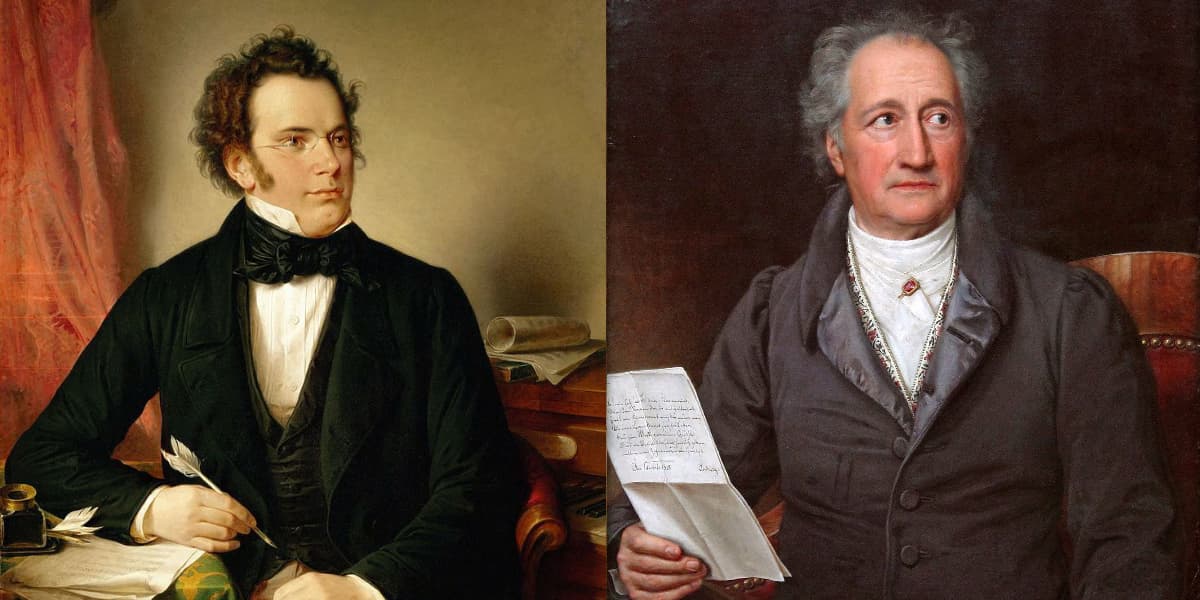George Crumb: Madrigals, Book II and Songs, Drones and Refrains of Death

Franz Schubert and poet Johann Wolfgang von Goethe
Franz Schubert’s hair-raising setting of Goethe’s poem about a father with an ailing child in his arms, racing towards help but being thwarted by the illusions of the Erlkönig has always had dramatic performances. The singer has to project 4 different voices (the narrator, the father, the child, and the Erlkönig), conveying the worry of the father, the fretting of the child, and the temptations of the Erlkönig. But it’s the piano that established the urgency through its first pounding entrance. When we finally draw up, it’s that final, fatal pause before the last two words, ‘war todt’ (is dead), that shines a light on the futility of the journey.
Franz Schubert: Erlkönig, Op. 1, D. 328 (Thomas Dolié, baritone; Olivier Godin, piano)
It’s the contention of American composer George Crumb that Schubert’s setting of Goethe’s poem was an inspiration to the Spanish poet Federico García Lorca’s poem “Song of the Rider, 1860,” which Crumb used in two of his works, Madrigals, Book II (1965), where he just set 4 lines, and in Songs, Drones and Refrains of Death (1968) where he set García Lorca’s entire poem.
Much like Erlkönig, Crumb’s version starts at a dead run with the instructions: ‘breathlessly, with relentlessly driving rhythm!’. The work, for baritone, electric instruments, and percussion, carries the motion of the black horse through the wild, hammered rhythms played on lujon, crotales, drums, mallet instruments, and electric harpsichord.

George Crumb and Federico García Lorca
The vocal setting is rather like Schoenberg’s Sprechstimme, with its rises and falls, lines read with rubato – speeding up and slowing down, and, of course, with the occasional neigh of the horse in the vocal line.
Canción del Jinete (1860) | Song of the Rider (1860) |
En la luna negra | In the black moon |
de los bandoleros, | of the bandits, |
cantan las espuelas. | the spurs sing. |
Caballito negro. | Little black horse |
¿Dónde llevas tu jinete muerto? | Where do you take your dead rider? |
…Las duras espuelas | …The hard spurs |
del bandido inmóvil | of the motionless bandit |
que perdió las riendas. | who lost his reins. |
Caballito frío. | Little cold horse. |
¡Qué perfume de flor de cuchillo! | What scent of knife in bloom! |
En la luna negra | In the black moon, |
sangraba el costado | Sierra Morena’s. |
de Sierra Morena. | side bled |
Caballito negro. | Little black horse |
¿Dónde llevas tu jinete muerto? | Where do you take your dead rider? |
La noche espolea | The night spurs |
sus negros ijares | its black flanks |
clavándose estrellas. | nailing stars. |
Caballito frió. | Little cold horse. |
¡Qué perfume de flor de cuchillo! | What scent of knife in bloom! |
En la luna negra, | In the black moon, |
¡un grito! y el cuerno | a cry! and the long horn |
largo de la hoguera. | of the fire. |
Caballito negro. | Little black horse |
¿Dónde llevas tu jinete muerto? | Where do you take your dead rider? |
Federico García Lorca
Canciones 1921-1924: Canciones Andaluzas
George Crumb: Songs, Drones and Refrains of Death – III. Canción de Jinette, 1860 (Song of the Rider, 1860) (Ensemble New Art; Fuat Kent, cond.)
Crumb ends the work with a full cadenza appassionata for two drummers before the singer returns to perform the last 5 lines.
George Crumb: Songs, Drones and Refrains of Death – Cadenza appassionata for 2 drummers (Ensemble New Art; Fuat Kent, cond.)
Earlier, in 1965, Crumb had made another setting of this text, but only using 4 lines of the total.
George Crumb: Madrigals: Book II – III. Caballito negro Donde llevas tu jinete muerto? (Little black horse, where are you taking your dead rider?) (Tony Arnold, soprano; Rachel Rudich, flute, alto flute, piccolo; David Colson, percussion)
The smaller ensemble, dominated by the flutes, gives a very different feel from the much darker 1968 setting. Crumb only sets the two alternating refrains: Caballito negro. ¿Dónde llevas tu jinete muerto? And Caballito frió. ¡Qué perfume de flor de cuchillo! The singer also imitates the horse on the first vowel of negro.
Crumb is a long way away from Schubert, but with the help of the horse, we can see how Crumb’s madrigal set only 4 lines of the orginal poem because of the basis of his longer and more dramatic setting.
For more of the best in classical music, sign up to our E-Newsletter
